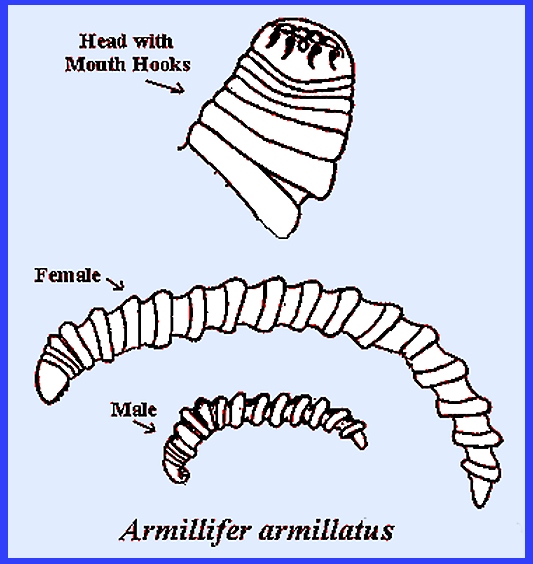File: <pentastomidamed.htm> <Medical
Index> <General Index> Site Description
<Navigate to Home>
|
PENTASTOMIDA (Tongue
Worms) (Contact) Please CLICK on
underlined links to view:
Of the two
orders the Cephalobaenida have mouth hooks situated on narrow extensions or
swellings of the body posterior to the mouth, whereas in the Porocephalida
hooks are arranged on each side of the mouth. The Life
Cycle is complex. The larval and
nymphal stages occur on one host while the adults are on another. For example, Linguatula serrata adults occur in the nasal passages and
sinuses of dogs and humans, where they suck blood. This results in severe bleeding. The parasite eggs are released in the mucus and infect the
surrounding environment of water or vegetation. If animals or humans consume the eggs the larvae hatch and
migrate through the intestinal walls and finally locate in the liver or other
organs where nymphs develop. A larva
that becomes encapsulated in host tissue then follows this, and nymphal
development continues. Nymphs mature
in 5-6 months and by then they have two pairs of hooks (4-6 mm long). Nymphs may live within cysts for 2-3
years. Then if raw meat is consumed
the nymphs access the nasal passages where they mature. The disease in humans is referred to as
"Porocephaliasis." The
severity of this disease in humans depends on how many nymphs are present. In America infections are not common,
probably because raw meat is not often consumed. Tongue worms
are especially common among Europeans, and in Africa Armillifer armillatus is the species most found both in
humans and wild animals, such as snakes and monkeys. The inhabitants of some parts of Africa
that consume "bush meat" are often infected. In South America a principal problem
species is Porocephalus clavatus
whose alternate hosts are snakes. Key References: <medvet.ref.htm> Matheson, R. 1950.
Medical Entomology. Comstock
Publ. Co, Inc. 610 p. Service, M. 2008.
Medical Entomology For Students.
Cambridge Univ. Press. 289 p |
